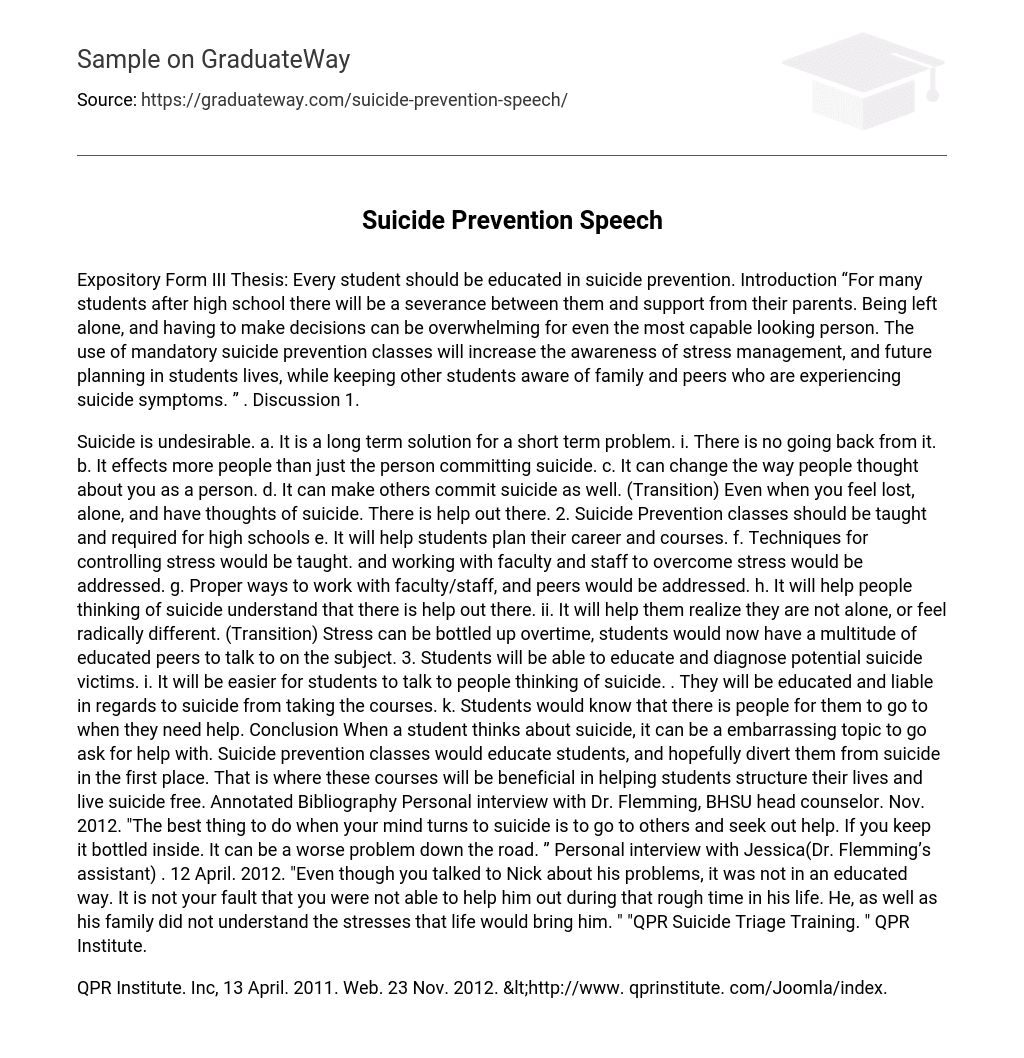Expository Form III Thesis: Every student should be educated in suicide prevention. Introduction “For many students after high school there will be a severance between them and support from their parents. Being left alone, and having to make decisions can be overwhelming for even the most capable looking person. The use of mandatory suicide prevention classes will increase the awareness of stress management, and future planning in students lives, while keeping other students aware of family and peers who are experiencing suicide symptoms. ” . Discussion 1.
Suicide is undesirable. a. It is a long term solution for a short term problem. i. There is no going back from it. b. It effects more people than just the person committing suicide. c. It can change the way people thought about you as a person. d. It can make others commit suicide as well. (Transition) Even when you feel lost, alone, and have thoughts of suicide. There is help out there. 2. Suicide Prevention classes should be taught and required for high schools e. It will help students plan their career and courses. f. Techniques for controlling stress would be taught. and working with faculty and staff to overcome stress would be addressed. g. Proper ways to work with faculty/staff, and peers would be addressed. h. It will help people thinking of suicide understand that there is help out there. ii. It will help them realize they are not alone, or feel radically different. (Transition) Stress can be bottled up overtime, students would now have a multitude of educated peers to talk to on the subject. 3. Students will be able to educate and diagnose potential suicide victims. i. It will be easier for students to talk to people thinking of suicide. . They will be educated and liable in regards to suicide from taking the courses. k. Students would know that there is people for them to go to when they need help. Conclusion When a student thinks about suicide, it can be a embarrassing topic to go ask for help with. Suicide prevention classes would educate students, and hopefully divert them from suicide in the first place. That is where these courses will be beneficial in helping students structure their lives and live suicide free. Annotated Bibliography Personal interview with Dr. Flemming, BHSU head counselor. Nov. 2012. “The best thing to do when your mind turns to suicide is to go to others and seek out help. If you keep it bottled inside. It can be a worse problem down the road. ” Personal interview with Jessica(Dr. Flemming’s assistant) . 12 April. 2012. “Even though you talked to Nick about his problems, it was not in an educated way. It is not your fault that you were not able to help him out during that rough time in his life. He, as well as his family did not understand the stresses that life would bring him. ” “QPR Suicide Triage Training. ” QPR Institute.
QPR Institute. Inc, 13 April. 2011. Web. 23 Nov. 2012. <http://www. qprinstitute. com/Joomla/index. php? option=com_content&view=article&id=315&Itemid=120>. “This program requires only 6 hours of training to complete. The cost at a group rate inside of a school function would be very manageable for a school to pay for. Goals of this program include: Raise public awareness about suicide and its prevention. Provide low-cost, high-tech, effective, basic Gatekeeper and intervention skills training to lay persons who may be able to prevent a suicide.
Provide suicide prevention and intervention training programs for a variety of professionals and for undergraduate, graduate and post-graduate students preparing for careers in the helping professions(or in other words, get people aware of suicide) “Teen Suicide Statistics. ” Teen Depression. Ad Choices, n. d. Web. 25 Nov. 2012. <http://www. teendepression. org/related/teen-suicide-statistics/>. Suicide is the third leading cause of death among adolescents and teenagers. According to the National Institute for Mental Health (NIMH), about 8 out of every 100,000 teenagers committed suicide.
In a survey of high school students, the National Youth Violence Prevention Resource Center found that almost 1 in 5 teens had thought about suicide, about 1 in 6 teens had made plans for suicide, and more than 1 in 12 teens had attempted suicide in the last year. As many as 8 out of 10 teens who commit suicide try to ask for help in some way before committing suicide, such as by seeing a doctor shortly before the suicide attempt. Teen girls are more likely to attempt suicide, but teenage boys are four to five times more likely to die by suicide.





